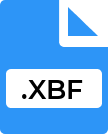.XBF File Extension

XAML Binary File
| Developer | Microsoft |
| Popularity | |
| Category | Developer Files |
| Format | .XBF |
| Cross Platform | Update Soon |
What is an XBF file?
.XBF files are associated with XAML, or Extensible Application Markup Language, a markup language developed by Microsoft.
XAML serves as a declarative language utilized primarily for creating user interfaces in applications, particularly in the Windows ecosystem. With .XBF files, XAML is encoded in a binary format, optimizing storage and processing efficiency while retaining the descriptive power of its XML-based counterpart.
More Information.
Upon its inception, the .XBF format emerged as a solution to enhance performance and reduce file size in applications leveraging XAML.
By encoding XAML markup into a binary structure, .XBF files enabled faster parsing and rendering, crucial for delivering responsive user experiences in software applications.
This optimization was particularly valuable in resource-constrained environments or applications with intricate user interfaces.
Origin Of This File.
The genesis of .XBF files can be traced back to the evolution of XAML itself. Microsoft introduced XAML alongside the .NET Framework, aiming to streamline the development of graphical user interfaces for Windows applications.
As the .NET ecosystem expanded, so did the need for efficient handling of XAML files, prompting the creation of a binary representation: the .XBF format.
File Structure Technical Specification.
.XBF files exhibit a structured layout optimized for efficient storage and parsing. Unlike their XML-based counterparts, which store markup in plain text, .XBF files encode XAML data in binary form.
This binary encoding reduces file size and parsing overhead, facilitating quicker access to UI definitions.
At its core, the .XBF file structure comprises a series of binary-encoded elements representing XAML objects, properties, and their values. These elements are organized hierarchically, reflecting the structure of the user interface defined in XAML.
Additionally, .XBF files may incorporate metadata and optimization techniques to further enhance performance and compatibility.
How to Convert the File?
Converting .XBF files to other formats, such as plain text XAML, typically involves using specialized software tools or libraries capable of decoding the binary-encoded data. Several approaches to file conversion include:
- Utilizing Framework APIs: Development frameworks like .NET provide APIs for loading and parsing .XBF files, enabling conversion to other formats programmatically.
- Third-party Conversion Tools: Various third-party tools offer functionality for converting .XBF files to XML or other human-readable formats, often through graphical user interfaces or command-line interfaces.
- Custom Conversion Scripts: For advanced users or specialized scenarios, custom scripts or utilities can be developed to decode .XBF files and extract their contents in the desired format.
Advantages And Disadvantages.
Advantages:
- Improved Performance: Binary encoding reduces file size and parsing overhead, leading to faster loading and rendering of user interfaces.
- Enhanced Security: Binary-encoded data is less susceptible to tampering and reverse engineering compared to plain text formats.
- Compact Storage: .XBF files occupy less disk space than their XML counterparts, optimizing resource utilization.
Disadvantages:
- Limited Compatibility: While well-suited for Windows applications, .XBF files may pose compatibility challenges when integrating with non-Microsoft platforms or tools.
- Reduced Human Readability: Binary encoding obfuscates the underlying XAML markup, making .XBF files less accessible for manual inspection or editing.
- Complex Conversion Process: Converting .XBF files back to human-readable XAML format may require specialized tools or libraries, adding complexity to development workflows.
How to Open XBF?
Open In Windows
- Native Support: Windows systems provide native support for .XBF files, allowing them to be opened directly by applications developed using the .NET Framework or other frameworks that support XAML.
- Visual Studio: Microsoft Visual Studio, a popular integrated development environment (IDE), supports .XBF files and provides tools for viewing, editing, and debugging XAML-based user interfaces.
- Third-party Applications: Various third-party applications compatible with Windows, such as XAML editors or design tools, offer functionality for opening and manipulating .XBF files.
Open In Linux
- Mono: Mono is an open-source implementation of the .NET Framework that supports running .NET applications on Linux. Applications developed with Mono can potentially open .XBF files on Linux systems.
- Wine: Wine is a compatibility layer that enables running Windows applications on Linux. Using Wine, it may be possible to run Windows software capable of handling .XBF files on Linux distributions.
Open In MAC
- Mono: Similar to Linux, Mono can be used on macOS to run .NET applications, potentially allowing .XBF files to be opened using compatible software.
- CrossOver: CrossOver is a commercial compatibility layer based on Wine that enables running Windows applications on macOS. It may support opening .XBF files through compatible Windows software.
Open In Android
- Third-party Apps: While Android is primarily a mobile operating system, there may be third-party applications available on the Google Play Store capable of opening .XBF files, particularly if they are associated with XAML-based development or design.
Open In IOS
- Third-party Apps: Similar to Android, iOS is a mobile operating system, but there may be third-party applications available on the App Store that support opening .XBF files, especially if they are designed for XAML-based development or design tasks.













